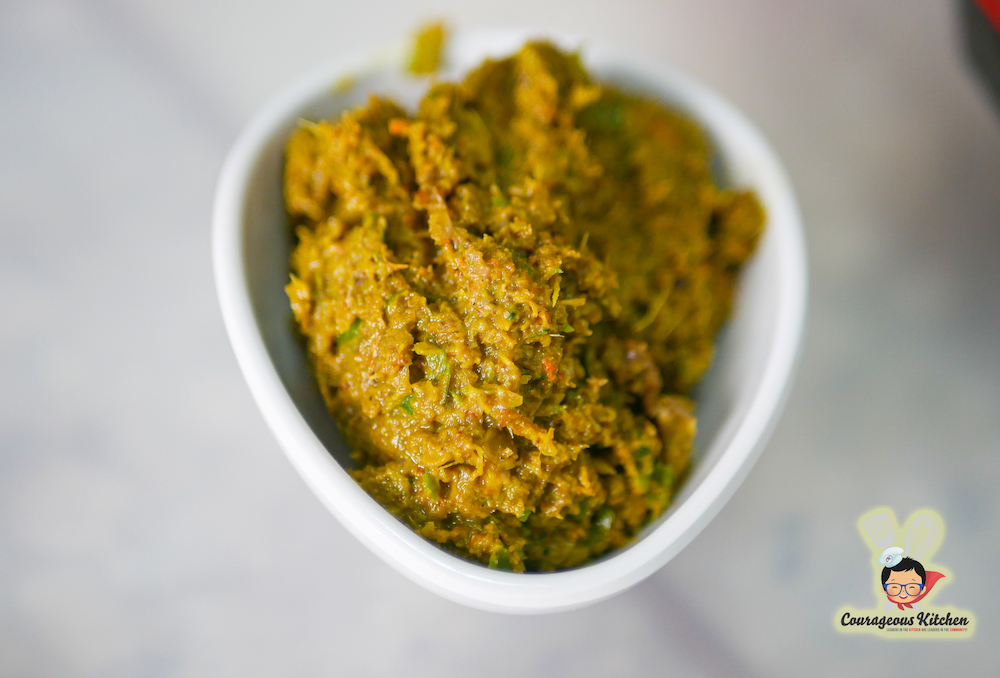In our last recipe we covered how to make a quick green curry once you have paste in hand. We even followed that up with some options for anyone looking for substitutes to using shrimp paste and soy products. That’s already a lot of ground to cover, but this week we’re backtracking a bit to talk how exactly we make an awesome green curry paste.
Want to make a similar spicy green curry paste to the ones you tried in Thailand? This takes some practice and patience, but it’s possible. Everyone’s kitchen and tastes are different so an exact recipe is also tough. Today we tackle these challenges and hope to encourage more people around the world to make their own curry pastes. Lovers of green curry, let’s raise the bar of this delicious curry.
One promise we can make, fresh curry paste is ALWAYS better than the packaged kind.
Green Curry Paste Components
Early warning: making your own curry paste can be a mess. If you’re not in Thailand you don’t likely have all the tools you need for the job. Many folks based in cities in Thailand, may not even have space in their kitchen. However, if you have can figure out a method to pound, grind, and blend all of these ingredients together you can make a colorful, nutrient packed curry paste to share with your family.
Most Thai curry pastes are a mix of the following:
- (1) dry spices
- (2) chili
- (3) aromatic roots
- (4) fresh herbs
- (5) shrimp paste
Curry Paste Crushing and Pounding Tools
Your mission then, is to decide how best to combine all of those ingredients together. Thais traditionally use a mortar and pestle. They are made from heavy granite and when you give them plenty of elbow grease, they’re great at pounding these varied types of ingredients into a paste. In a modern kitchen you may not have this as an option. So you need to find whatever you can to crush the dry spices, and others you can put in a food processor or blender. Here are some options:
Traditional Thai mortar and pestle
Spice grinder + blender/ food processor
Large rock + blender / food processor
Large rock? Are you serious. Yes! There have been occasions when cooking for people while traveling, where I haven’t had everything I needed to crush spices. If that happens, feel free to go flintstone on these spices. Whatever you gotta do, dinner must go on! Just be sure to wash the rock well and have a suitable surface you can pulverize thing on. The best curry mortars are made of stone after all! Once back to my regular kitchen, I appreciated the hand chiseled granite from Angsila, Thailand so much more.
Remember when you read the recipe below that your rock or spice grinder is mainly for your dry spices. Depending on your machine, you may need some practice getting the paste to be the consistency you desire. This is normal, and you can even add a bit of water or stock if things are getting caught in your machine. If you’re doing it for the first time, I would suggest you don’t blend too smooth.
That sorted? If you still have questions you can comment below. After the recipe, we’ve provided some trouble shooting questions people ask regularly. We hope this helps you make a more authentic green curry. If you enjoy, your support of Courageous Kitchen via our donation pages is much appreciated.

Green Curry Paste Ingredients
Dry spices
1 tsp peppercorn (white peppercorn is most common, but any will do)
1 tsp cumin
1 tbsp coriander seed
Chili
5-10 small spicy Thai green chili (spice lovers can hunt for the “prik kee noo”)
5-10 green medium to large chili (“prik chee fah”, serrano or similar)
1 tbsp of salt (optional if grinding by hand)
Roots
3-4 coriander roots
1 knob of galangal
1 knob of turmeric
Note: 1 knob for this purpose is roughly 30-40 grams or 2-3 tablespoons if using the powdered form.
Herbs
4-8 garlic cloves
4-6 shallots (small, sweet ones preferred)
1 tbsp of kaffir lime zest (about half of a kaffir lime)
2-3 lemongrass stalks sliced small
Shrimp Paste
1 heaping tbsp of shrimp paste
Green Curry Paste Instructions
- Toast your dry spices. (Optionally any of your roots can be toasted at this time as well.)
- Grind your dry spices and set aside.
- If pounding by hand, grind your chili in the mortar with salt. After smooth begin adding all other ingredients, including dry spices gradually.
- If using a blender combine everything, adding stock or a small amount of coconut milk to help the paste blend together.
- Store your curry paste in an airtight container in the fridge or get cooking with a green curry recipe right away.
- Fresh green curry paste oxidizes quickly and won’t look vibrant for long. If you don’t plan to use the paste the same day, pan fry with oil and then keep in an airtight container. In the refrigerator, this can last as long as a month.
—————————————————————————–
Green curry paste ready? Now try our recipe for a rich coconut milk green curry to feed the whole family.
—————————————————————————–
What if I don’t have a spice grinder or rock (lol)?
Don’t forget you can get coriander, peppercorn and cumin in powder form. The reason we prefer the whole spice is because the flavor is more intense, especially after toasting. However, work with what you have and make sure they are incorporated well into your paste.
What can I make with my curry paste besides curry?
Feel free to get creative with your green curry paste. You can use it as a marinade. You can use it to make a spicy sauce to cover steak. One of our favorites? Green curry fried rice!
Can I just dump everything into the mortar or blender?
We see people using the dump method. But depending on the texture you want at the end, we don’t always recommend it for beginners. Adding your ingredients gradually allows you to make sure things incorporate smoothly and you can add or adjust flavors as needed. Then when you’ve made the curry a bunch of times and know what you love (or what your blender can handle), you can take liberties with how you add the ingredients.
Can I use a marble mortar and pestle?
Found a small mortar and pestle in the kitchen store? This is likely used for dry spices and medicine. You can use it to start your curry paste, but you don’t want to be trying to crush things like lemongrass in there because it will likely take forever. I would use it to crush your dry spice, and then move everything to a food processor or blender.
I can’t find coriander root. Can I substitute the coriander stems or add bell pepper?
People use leaves and stems to help with the color (shouldn’t be needed for this recipe), but it isn’t a good substitute for the flavor of the root. If you go without it, try upping the amount of toasted coriander seeds you add.
If you need to use milder chilies and peppers you can. Just be aware the flavor and water content of them (bell pepper for instance) will change the nature of the paste.
Do you use the same paste for different types of meat?
You can use this generic recipe for any meat. However, if you’re cooking fish, beef, or game meat, we may increase the dried spices and also add more root aromatics. The best part of making your curry paste is the ability to customize it as needed. When Thai chefs customize the curry to the protein, for example adding extra fingerroot when cooking with fish, that’s a sign of next level expertise!
Why is my green curry so light green?
Typically the curry will come out light green. If you want a stronger color, this is really the purpose of the knob of turmeric as an ingredient. You can add more to intensify the green, but be careful it doesn’t start going orange. Turmeric, like the other roots Thais love, is also very healthy for you.
If you’ve seen Netflix’s Chef Show, you may have seen them add the coriander stems, basil, and all sorts of stuff to make it green. Yes, this is possible, but not what we recommend, nor how it’s done it Thailand. That method is more of a quick trick in the kitchen when you’re in a panic and need curry.
Is there a substitute for galangal?
No. There is no substitute for galangal. However, if you can’t find it fresh you can use the dried kind.
Many people make the mistake of thinking ginger is interchangeable. They are not. You can use ginger if you have no other option, but it will change the flavor. This is no major sin though, as ginger is used in some types of curry pastes. However, when using it for the first time, be conservative. The flavor and spice level may surprise you, as it can be more pronounced than roots like galangal and turmeric.
Similar to people adding green leaves to improve the color of your curry, you can do it, but it will require trial and error if you’re chasing a real Thai style curry flavor.
How can I store my fresh curry paste? Can I freeze it?
Your fresh paste won’t last too much longer than a few days in the fridge. Green curry paste especially has a habit of oxidizing even after only a few hours in the fridge (we should be very afraid of the store-bought pastes that last forever and never change color). To extend the life beyond a week, pan fry the curry paste with a few tablespoons of oil. Then spoon it into a jar or sealed container and store in your refrigerator for as long as a month.
You can freeze your paste as well. But don’t expect the thawed version to be as flavorful. To remedy this, refresh your paste with freshly pounded or grounded aromatics (like chili, garlic, and shallots). We prefer it fresh, but this can be a big timesaver when you have made more paste than you can use easily.
Will my green curry paste be ruined if I’m missing an ingredient?
No. Overall curry paste if pretty forgiving and tolerant of lots of variations. The exception would be when working in a restaurant or cooking for Thai guests. Then you want to make your best efforts to create a traditional curry. If you’re just spicing up dinner for your family, go full on into this project with the spirit of exploration, not fear.
We’re confident the results will be delicious!
Happy cooking!





